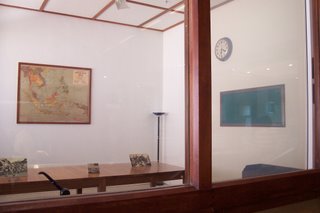I went for the bus tour entitled War on Wheels, Invasion Singapore! during the weekend. This event gets its participants to discover more about Singapore's World War II history.
It was worth the effort to be out early in the morning on a weekend. The bus tour brought the tour group to several important sites to better appreciate the significant events that had taken place when Singapore was invaded by the Japanese military in 1942. It also gave us a glimpse of the civilians' experience of the Japanese occupation and the end of the occupation.
What I particular like was how the tour guide invited the participants to imagine that we were back in time. On the bus, the tour guide shared anecdotes to help the participants to imagine how it was like during the years 1942 - 1945.
So when the bus brought us participants to the Kranji park which used to be mangrove swamps back in Feb 1942, it was not too difficult to imagine that on 8 Feb 1942, soldiers from the Japanese military had advanced across the Straits of Johor and landed on the main island of Singapore using make-shift boats etc. I realised that the Straits of Johor was a comparatively shallow and narrow body of water. Furthermore, the tides at the Kranji landing sites weren't very strong. What this meant for me was that even when the Causeway was destroyed back then, it was not too much a great challenge for the Japanese to attack and land on Singapore once they have reached the southern tip of the then-Malaya.
If I were a military historian, I think there would be a lot of learning points just by reading the strategies that the British had used to defend Singapore, and the strategies that the Japanese had used to attack Singapore more than six decades ago. At the very least I have learnt from this part of history that one should never underestimate one's enemies when planning one's strategies.
The second stop was the Kranji War Memorial. The memorial was built and maintained by the Commonwealth War Graves Commission. "The Kranji War Memorial commemorates the contributions of 24,000 soldiers of the allied forces who died during World War II" (source: http://infopedia.nl.sg/articles/SIP_183_2004-12-27.html). Participants were invited to a simple activity as an act of remembrance to those who have laid their lives during the war. I shall not attempt to reveal much about the activity here since I figured that some may decide to attend this tour during one of the next two Saturdays.
Having a memorial built for those who have died during the war may bring some comfort to their loved ones and off-springs. On the other hand, the rows of graves and names on the memorial walls reminded me of one thing: War itself has neither eyes nor compassion, even if countless were to die in the name of war.
I wish for peace to prevail.
The third stop was the Memories at Old Ford Factory. This was where the British had surrendered Singapore to the Japanese. As the bus tour was meant to be a sampler of the various key sites, the participants only had about 15 minutes at the museum. Nevertheless, I had a glimpse of the chamber where the surrender had taken place, and I had some time to read about what had taken place during the surrender. The process that had taken place during the surrender just seemed like a psychological game to me.
At the Memories at Old Ford Factory, there were two short activities that the participants were invited to take part in. During the tour, we also got to see a real "banana money", the official currency that was used during the Japanese Occupation. Well, it reminded me that there are many things that money cannot buy.
Following the stop at the Memories at Old Ford Factory, the bus brought us for a short ride of Alexandra Hospital. This hospital used to serve as a military hospital. On 14 Feb 1942, what I see as a series of atrocious war crimes had taken place here.
After lunch, the bus brought participants to the Reflections at Bukit Chandu. Here, participants learnt about the bravery of the Malay Regiment. I have visited this museum for several times and I can't help but feel a deep sense of respect for the soldiers of the Malay Regiment who have put up their very best to fight a good battle.
 Photo taken at Surrender Chambers of Fort Siloso, Sentosa. The actual surrender took place at City Hall.
Photo taken at Surrender Chambers of Fort Siloso, Sentosa. The actual surrender took place at City Hall.The tour concluded at City Hall. It was at City Hall, the then Municipal Building of Singapore, where the surrender of the Japanese had taken place. I was imagining that even when everyone cheered for the end of the war, life for people in Singapore would not be quite the same after a war. Nevertheless, the end of the war definitely called for a celebration.
If you should find my short write-up about this bus tour to be interesting, you may wish to know that you can register for this event War on Wheels by visiting SISTIC. There will be bus tours on 21 and 28 Nov 2009 (Saturdays). Please see this site for more information: http://www.museums.com.sg/es09/war-on-wheels.html




